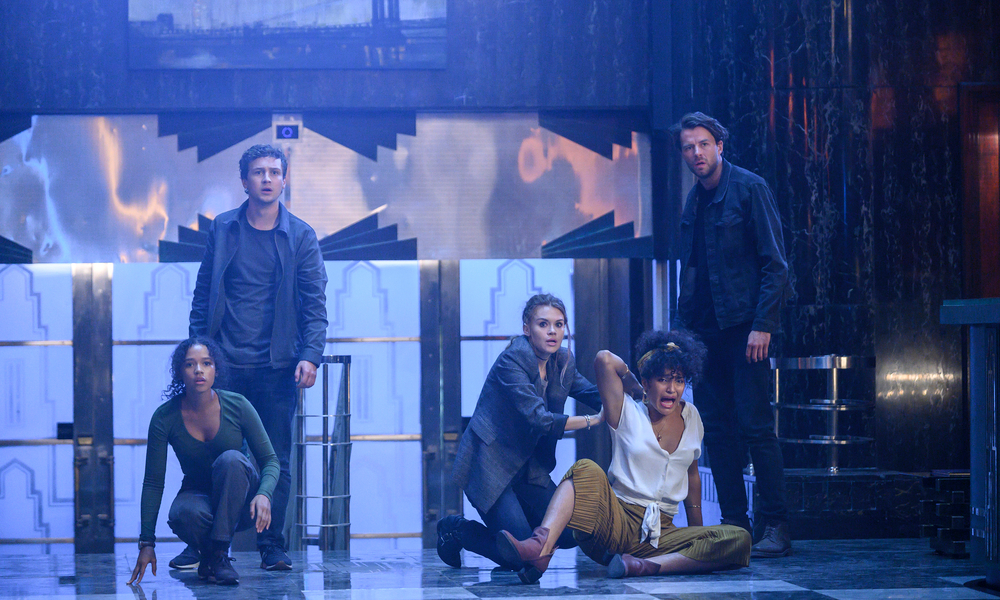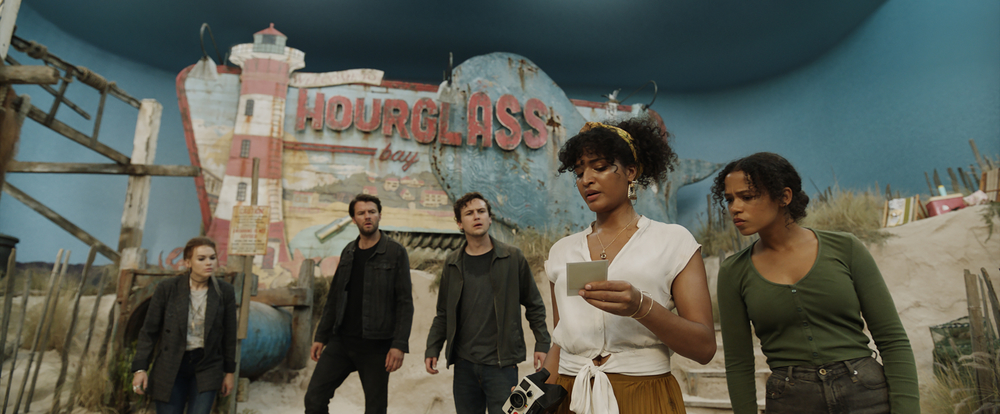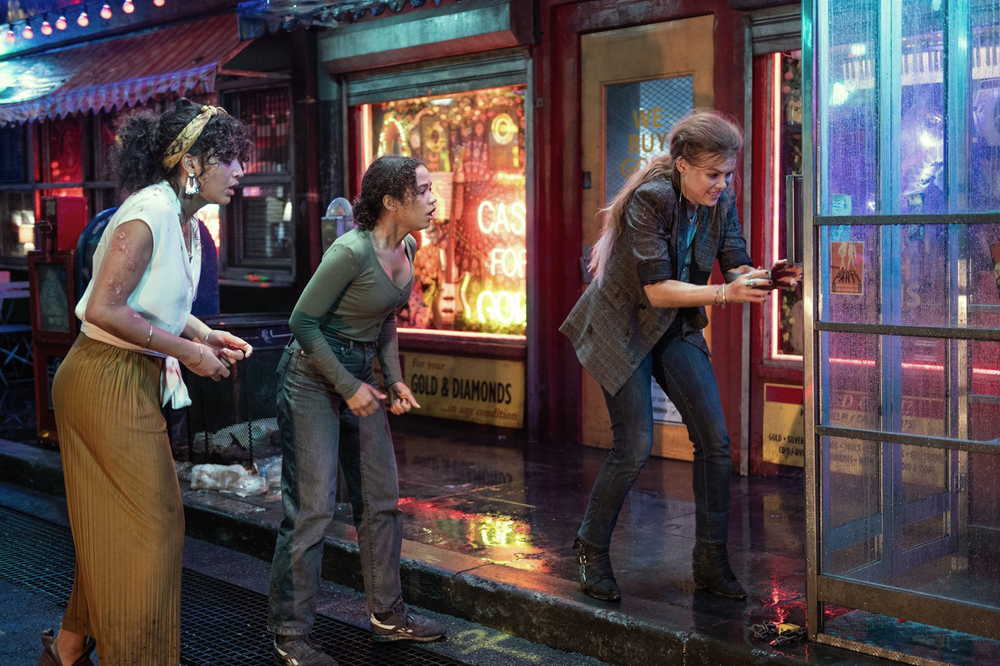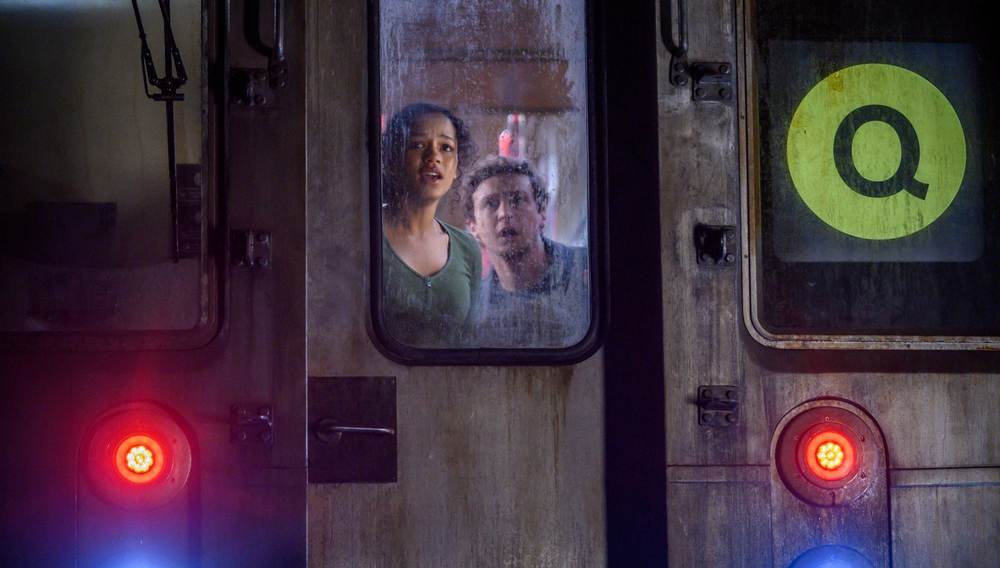Horror movies might be designed for scares, but quite often—in between the shrieks—they’re just plain fun. Such is the case with Escape Room: Tournament of Champions, the latest in a handful of horror films (A Quiet Place Part 2, Spiral, The Conjuring: The Devil Made Me Do It, The Forever Purge) to entice North American theatergoers as the industry recovers from the Covid-19 pandemic.
A sequel to 2019’s Escape Room—a box office success both domestically and internationally—Tournament of Champions ups the stakes from its predecessor, adding new heroes, new information on the villainous Minos Corporation, and—c’mon, we know what you’re really here for—more inventively designed escape rooms that’ll kill you if you can’t unlock its secrets. In advance of its theatrically exclusive debut on July 16, director Adam Robitel sat down with Boxoffice Pro to talk about upping the escape room ante and the power of horror on the big screen.
Congratulations on a really, really fun movie. I wish I’d seen it on the big screen instead of my TV, because some of those sets were so beautiful and immersive looking.
Thank you for saying that. The mix to the sound is just incredible. It’s really like a roller coaster ride. The mix just brings it to life in a way that, you hear the crunch of a ceiling or a laser come by your head, and it is genuinely a different experience.
The sets in the first one were already so great. How do you top that? Or were you even trying to top that?
It was a tall order. I felt like, if we’re going to do a sequel, we have to kind of outdo ourselves. And I think the first “Ah ha!” was—I’ll never frankly feel like I outdid the billiard room [from the first Escape Room], ’cause it’s my favorite room. But I thought, how can we do stuff that subverts expectations? And it was Zoey revenge story. We knew she was going to go to Manhattan. I thought subway car—wouldn’t it be cool if we expanded the game in the sense that any place that you go to or enter that you could relate to could be turned into a game? And that’s where it naturally led its way to. I saw this great image in my mind of a train car derailing. The third rail turning into an electrical storm.
That was sort of the beginnings of it. Minos had a whole underground warren of space underneath New York City? It’s tough. These are PG-13 movies. We always have to come up with a space that is, as I say, “Beautiful, but deadly.” There were a lot of things that hit the editing room floor in terms of development. But we landed on a bank, a beautiful art deco bank. I have a great production designer by the name of Ed Thomas. We shot the movie in Cape Town. And so it was a function of like, “Okay, we’ve got the train idea. What about lasers and a huge bank? That would be really cool.” And we fortuitously found this amazing location in Cape Town, this beautiful bank that we retrofitted.

And then further on, initially, we thought, “Oh, what about sand?” ‘Cause in the first movie we killed them in so many different ways. We have fire, we have gravity, we have gas. All the big ticket items of ways to kill people we did in the first movie. Coming up with just the modus operandi of killing people was difficult. And so I thought, “What about sinking through sand? Like, that’s scary.” We initially thought maybe an ancient temple or something. And then we thought, “That’s not really our movie.” And then we came up with the idea of a great Cape Cod-type beach that then transforms and tries to swallow our contestants. It was an iterative process. Definitely the hardest part of the script was landing on the rooms that would feel like an Escape Room movie.
And then, of course, they get past the beach, and they get into what they feel is an outside, New York City cross section of a street, and then there’s going to be acid rain. What’s really fun about the sequel is that the rooms themselves are telling a different narrative. They’re going lead to this reveal that’s different than the first movie in a sense, building intrigue. But it’s not about the character backstories, it’s about a piece of the puzzle that Zoey’s gonna learn about. But yeah, it was tough.
By the time you get to movie three, four or five, it’s almost going to be like Mad Libs to come up with new rooms. “Killer…. sushi!”
Oh, yeah. Trust me. We’re talking about crazy pitches. Like a spacewalk with anti-gravity where they’re in space suits and they have to like fix the O-ring…You know, stuff like that. There’s the great molasses flood, which happened outside of Boston. I pitched a death by sugar. If you do research, the great molasses flood killed like 70 people. There’s been a lot of Honey, I Shrunk the Kids. There’s been a lot of different crazy ideas to get to the spaces that we ultimately have in the movie. And what’s cool with the sequel, frankly, is there’s a motel room, you think they’re safe, and then suddenly the ceiling comes down. There’s really no place you can go and be safe. If I were these two contestants, I would be living in a tent in the middle of Yellowstone.
You wouldn’t be safe even then.
That’s true.
You could do a historical period drama version of it. Minos: Origins.
[Laughs] Exactly. Yeah. A couple of prairie folk come by.

For the first movie, you said in another interview that you weren’t a huge movie, so a lot of the stuff with the escape rooms had to be done with practical effects. With this one, obviously—Escape Room had success, domestic and international—presumably you had more of a budget to play with. What was the balance of practical versus CGI on this one?
There was certainly more CG elements in terms of the electricity. The lasers were naturally done in post. But the sand was all practical. It was a very, very logistically challenging set. It was a massive set. It was built up on this giant rostrum. And underneath the 20,000 kilos of sand there were these boxes that would aerate the sand, and after about a minute or so, the actor could start to sink. It was liquefying the sand, practically. Now, it was kicking up dust everywhere. It was scratching people’s corneas. It smelled like a bog in Boston Harbor. So it was a very challenging environment. The pier was on hydraulics, so we could sink it. The crab shack was on hydraulics and on a roll bed so it could turn.
And other things that are really cool. The entire background when Indya Moore’s character takes the [Polaroid] picture [of the beach set] and it turns into a wall, that was a massive piece of fabric where we went out and took a photograph of a beach and lined it up perfectly with my DP Mark Spicer. And then we had to have it flown in from Europe. Every room was incredibly challenging. The rain in the acid rain room, that was all practical. The water elements that we shot in the movie are all practical. Fire was not practical, I will admit that, although we did shoot practical plates of it. It was definitely more CG-driven, but whenever we could, we tried to do stuff practically.
You don’t want to kill your actors, if you can avoid it.
[Laughs] No, that’s usually frowned upon.
I love with the sand scene, that bubbling effect. Because you think, “Oh, okay, I get it, it’s quicksand.” But just the fact that it’s that little bit different kind of adds that level of creepy unexpectedness.
It was part and parcel of the way the special effects team was doing the aeration. At first we thought, “Oh, God, it looks like porridge.” Bubbling oatmeal. But we kind of leaned into that look, because we were doing some CG enhancements, and they had to kind of be close to what we got in-camera. So a lot of it was predicated on that Minos has these massive machines underneath the sand. A lot of the intellectual game that we would play with ourselves was like, “Well, how would they actually do this? How would they build these rooms? How would they get them into these spaces so quickly?” And that question is answered in a very cool moment later in the movie, when we see a little bit behind the curtain, so to speak, and we go, “Okay, that’s where it makes sense.” They are like the Amazon—they are like the Jeff Bezos of death rooms. They have supply lines and the logistical acumen to pull this off.
You have to get yourself inside the head of a sadistic Jeff Bezos.
Yes, exactly. I always like the idea that all these Amazon trucks that we see going back and forth are actually pieces of escape rooms being sent to different cities.
I mean, we don’t know. Could be.
We don’t know.

With the first movie, I think it’s fair to say it did better than people expected it to. It was kind of an underdog, right? Do you perceive it the same way, or am I being unfair?
Yeah, look, I always believed in the idea. And I thought, there’s a lot of movies out there, and I felt like we had a good hook. It sort of felt like preexisting IP. Escape rooms are incredibly popular all over the world. So I thought it had a shot.
And then what we tried to do is have evocative images and a rootable heroine in Taylor Russell. These movies ultimately are sort of girl power movies in a way. Taylor’s character goes from a mousy, really neurotic and fearful and anxious young woman to, at the end of the movie, she’s ready to tear down the walls and burn the place to the ground. For me, that’s always fun to have a character you’re not expecting become the hero. And I think it travels internationally because it’s such a high concept idea. The rooms are sort of the star of the of the movie. You kind of know exactly what you’re getting, and I think a movie like this cuts through the clutter in a way that is pretty profound.
It was just fun. In the second one, you get some more of the mythology, but I even feel like that’s still window dressing to just the rooms.
Yeah, I mean, it’s always tough. I think people want to know answers. But as soon as they have the answers, they don’t want the answers. You know what I mean? I was saying in an earlier interview, we’re in this day and age where after this pandemic, I think we all feel like we don’t necessarily have total agency over our lives. And that there are the Machiavellian forces—you know, whether it’s a virus, or the Illuminati. This idea that there are—and there’s so many conspiracy theories in our country, and it seems like now in this sort of post-truth world, people are looking for patterns where maybe they don’t exist. They’re looking for these great conspiracies. And I think in some ways—not to get to film theory about it—the idea of Minos, the idea of these ultra-powerful behind the scenes, lurking, controlling our lives, is something that resonates right now.
Yeah, I would 100 percent believe that there are these rich billionaires out there just messing with people for fun.
Oh, yeah. I mean, why not? If they’re that bored, you know?
On the subject of the pandemic, I’m with Boxoffice Pro, so obviously we write a lot about box office and forecasting and analysis. Over these past few months, with the industry recovering and things starting to open up, we’ve seen some kind of indications of horror films and thrillers hitting with audiences. They’re doing well. A Quiet Place Part 2 did great. The Conjuring 3 did well, and it’s doing really well in some international markets. You’re a horror filmmaker, but also, I assume, just a fan of horror films. Do you have any any thoughts as to why that might be the case?
Well, I think they tend to skew younger. I think horror is always going to be a communal thing. It’s so much more fun to get scared with an audience. They’re great date movies or friends’ night out movies. And I think the horror crowd is probably a little more prone to be like, “Sure, I’ll go to a theater! I’m ready to go back.” Whereas I think–I don’t want to say the adults, because there’s a lot of adults who love horror movies–but the sort of adult fare that isn’t necessarily a theatrical experience, I can always watch that on HBO Max. There’s just that collective shudder that is so fun in a crowd that you can’t replicate by being at home, siloed in your apartment. I think going forward, genre stuff is going to be really the bailiwick that that helps buoy the studios. And I’m so grateful that we’re in a sort of Renaissance now.
My lament is the mid-level thrillers, you know, a movie like Prisoners, which is going to be harder and harder to make. The streamers are still making them, but you have to have a real high value proposition for people coming out of the pandemic to go to a theater. I was hearing anecdotally that the younger kids, because they’re not vaxxed yet, they’re struggling with kids’ movies still, because they’re less inclined to—
Peter Rabbit 2 didn’t do what anybody thought it would do in North America.
Yeah. Look, I do think it’s eventually going to take time. I feel like there’s going to be a percentage of the population who never comes back. And maybe I’m just being Debbie Downer. But eventually, it will normalize. It just might take another full year to rebound completely. God willing that this becomes something that we just go, “Remember that time, son, during the Covid?” Horror is just a vibrant thing, and the fans are rapacious. They love horror, and they show up and they tell their friends. And so I think it’s here to stay. Thank God.

Horror fans are intense. And I count myself among that group. They can be so, I’m gonna say protective, maybe a little judgmental sometimes, out of love of the genre—
They’re super passionate. I’ve had great experiences with them. They’re strangely more well-adjusted, I find, on the whole, than like the comedy crowd. Horror is a way to look at your own mortality, your own inevitable extinction, and laugh at it and get scared of it. And so I definitely consider it my tribe. And there’s always something new to be scared about.
I know everyone has their own personal comfort level, and it’s a personal thing. But have you had a chance to go back to theaters yet?
I have not, to be honest. I’ve been so busy with my various projects, and I literally just finished the mix on Escape Room last week. And now I’m working on a TV show. So I’ve been literally a hermit. I want to see A Quiet Place. I’d love to see Fast and the Furious. But I’ve just been too busy.
“I’m finishing making a movie” is a pretty good reason. Like, “No, I literally had to finish the movie for theaters, that’s going exclusively to theaters.”
The sad thing is, once you start making the sausage as a filmmaker, it’s all work to me now. I started watching “Hacks”on HBO just to laugh and be mindless, but anything I do now I’m always analyzing it and thinking about it. So I find solace more in reading. But there’s so many things I need to watch. I’m just so behind.
My final question, it’s one that I always like to ask and I’m always just really curious about it. Do you remember the first movie you saw in a theater? Or is there like a formative theater-going experience that sticks out in your head?
It’s funny, the previous interviewer was asking about movies that scared me. I brought up E.T., because I saw E.T.—I was very young, I saw it in a theater. And I just remember bawling my eyes out in the parking lot, like sobbing, holding my dad’s leg, “Why did you guys bring me to this terribly sad movie?” The power of those early Spielberg movies—I was a kid in the ‘80s, and so I think, any one of those movies just completely–Poltergeist just blew my mind and was terrifying. I’m definitely nostalgic for that period. But there’s been so many. I remember seeing Jurassic Park. Or Titanic for the first time and just being transported. There’s so many moments like that. I saw Independence Day in a drive-in in the middle of New Hampshire in a convertible, and the whole way home, just a starfield above us feeling completely terrified, thinking, “We are so screwed.” So yeah, those are a few of the more memorable ones.
The post Escape to the Cinema: <em>Escape Room: Tournament of Champions</em>‘s Adam Robitel Keeps Horror Going on the Big Screen appeared first on Boxoffice.
from Boxoffice





0 comments:
Post a Comment